This March sees the release of Batman vs. Superman. To celebrate, we’ll be looking at some iconic and modern Batman and Superman stories over the course of the month.
Max Landis has a relatively unique path to writing for Superman.
Landis is one of the most striking young writers to emerge from Hollywood in quite some time, making a strong impression through his collaboration with Josh Trank in the low-budget found-footage superhero film Chronicle. Landis has diversified somewhat since that original screenplay; a filmography that includes films like Mr. Right, American Ultra and Victor Frankenstein suggests that Landis’ interests lie more in unconventional pairings than in the superhero genre itself.

The Joker’s gags really bombed…
Nevertheless, Landis is a writer who does seem fascinated with the mechanics and underlying logic of superhero storytelling. A year before the release of Chronicle, Landis put together a short film that served as an extended discussion of The Death and Return of Superman featuring a variety of top tier talent like Mandy Moore, Elijah Wood, Ron Howard and Simon Pegg. At once reveling in the absurdity of the massive nineties comic book crossover and interrogating its central character’s identity crisis, it was a potent piece of pop culture criticism.
In the years following his initial success, Landis has remained relatively connected with the Man of Steel. He drafted an eight-page origin for the Atomic Skull for the first annual of DC comics’ relaunched Action Comics run, and would get a change to craft his own origin story for Clark Kent in American Alien. However, he also wrote a short two-issue story as part of DC’s digital-first The Adventures of Superman comic, scripting Superman’s first encounter with the Clown Prince of Crime.

Last laugh…
Given how comic book fans tend to obsess about continuity, it is ironic that so many of best (and most interesting) takes on iconic superhero characters tend to come from outside the rigid framework of the single interconnected shared universe. Even discounting DC’s continuity resetting with series like Crisis on Infinite Earths or Flashpoint, there is a legitimate argument to be made that many of their most engaging and compelling stories exist outside the burden of fitting with the editorial mandates of a single continuity.
To pick the most obvious examples, Watchmen and The Dark Knight Returns are hit just about every measure of success. They are two of the most consistent long-term sellers in the world of American comic books. They are well-loved among both fans and casual readers, counting among the most accessible superhero stories ever told. They have shaped and defined the American comic book industry for three decades, achieving a sort of cultural cache that is simply impossible for Grant Morrison or Scott Snyder’s Batman runs.
After all, one of the strengths of comic book characters – whether at DC or Marvel – is their ability to exist as archetypes that are instantly recognisable and immediately understandable. There is a serious argument to be made that the most enduring versions of Superman and Batman have little to do with their comic book iterations or even each other. To the public, Batman can be both Adam West and Christian Bale; Superman can be George Reeves or Christopher Reeve. That these stories and versions are irreconcilable makes no difference.
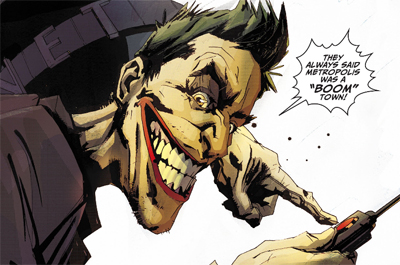
Pushing Supes’ buttons…
Even within mainstream comic books, this remains true. Grant Morrison’s All-Star Superman might not necessarily fit in the same continuity as the monthly superhero comic books featuring the character, but that does not render it any less iconic or influential a take on the character. During the nineties, DC’s all-ages comic books tying into Batman: The Animated Series and Superman: The Animated Series measured up to any of the in-continuity books published on those lines. Free of continuity, these classic characters can play as archetypes.
In some respects, this has been a major part of DC’s publishing strategy in recent years. The “new 52” represented a half-hearted embrace of this idea, a wishy-washy attempt to reset the line back to those archetypal parametres that was compromised by a reluctance to commit. For every genuinely “off-the-wall, from-the-ground-up” reinvention like Swamp Thing or Wonder Woman, there was a back-door through which all the baggage might come tumbling out like Batman or Green Lantern.
While the publisher’s post-Flashpoint relaunch was quickly mired in the sort of continuity shenanigans that the publisher had been trying to erase, the company committed to a looser tone in its digital offerings. Digital-first comic books celebrated the breadth and diversity of these iconic DC characters, refusing to trap them all within a singular streamlined continuity. There was room to revisit old settings with books like Batman Beyond and Justice League Beyond, or to resurrect Batman ’66.

Keep your chin up…
It was an approach that paid off quite well for the publisher. Nobody could have suspected, for example, that Injustice could work as well as it did; a digital-first tie-in to a generic fighting game predicated on some questionable storytelling choices. However, the book became a massive success for the publisher, to the point that has currently published well over one hundred issues. Batman ’66 has proven similarly successful, serving as one of the most entertaining books in the line and publishing a series of crossovers.
However, among the more interesting experiments of DC’s digital line are Legends of the Dark Knight and The Adventures of Superman, effectively two out-of-continuity anthology series that allow diverse talent the opportunity to craft simple self-contained narratives featuring some of the publisher’s most iconic characters. Indeed, DC would follow suit with Sensation Comics featuring Wonder Woman. The publishing brief was simple and very liberating; the books could provide a forum for both veteran writers and fresh talent to work with iconic properties.
The format of the books does place a few limitations on the kind of stories told. As digital-first publications, the comics are generally restricted to twenty horizontal pages that are formatted so as to be easily readable on a moderately-sized tablet. One digital page does not correspond to a full print page; it is typically treated as half of a print page. Each digital issue effectively amounts to ten print pages of a comic book, with a limited number of panels. The stories are then restricted to a handful of digital issues, with each issue needing to end on a cliffhanger.

No es-cape…
These formal restrictions create an interesting template for writers and artists. In effect, these digital anthologies task writers and artists with crafting ten- to forty-page stories. They are effectively equivalent to one- or two-issue stories in a print comic, but without the luxury of splash pages and without the weight of continuity. Long-form storytelling is all but out of the question, and even the basic storytelling grammar is different in terms of pacing and structuring. It would be impossible to do Court of Owls or Zero Year in this format, for example.
A large part of the fun of the format is watching writers and artists work with what is effectively a short-story format. As a result, stories tend be both broad and relatively simple. While many of the liberties of print comics are off the table, digital affords its own opportunities. It is possible to afford space to a story that would not really work as a headline story on a major monthly book; entire stories can be devoted to conversations between characters. Pitches can be simple. Free from continuity, almost anything is on the table.
And so it is with The Sound of One Hand Clapping, a short collaboration between writer Max Landis and artist Jock that brings Superman into contact with the Joker. It should be noted that this is far from the first time that this has happened. After all, those two characters are among the most recognisable and iconic characters in DC’s shared universe. The Joker is one of the best-loved villains in pop culture, while Superman is a iconic hero; it was a match-up that was bound to happen, even if it is hard to reconcile on a textual level.
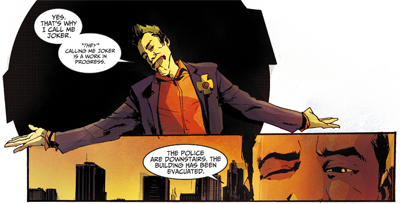
Laughin’ it up…
(Then again, the Joker’s popularity has a habit of rendering questions about his actual abilities relatively moot. In Last Laugh, for example, the Joker is able to render himself a global threat against the entire population of the DC universe. In Emperor Joker, Jeph Loeb gave the Joker the reality-altering powers of Mister Mxyzptlk so that he might pose a credible threat to the Man of Steel. Even within Scott Snyder’s End Game, the Joker is somehow able to mind-control the entire Justice League so as to use them as pawns against Batman.)
To the credit of Landis and Jock, The Sound of One Hand Clapping doesn’t strain to present the Joker as a credible antagonist to Superman. Indeed, Superman effectively resolves the Joker’s threat on the first page of the second issue. It is a nice touch, one that makes good use of the cliff-hanger structure of these sorts of stories by building to a shocking ending and then offering a deliberate anticlimax. In terms of sheer brute force, the Joker is not a threat to Superman. The idea that the Joker could pose a challenge to Superman is inherently ridiculous.
This is not a particularly shocking observation of itself. After all, it could be convincingly argued that The Dark Knight would be about two-hours shorter (and have a much happier ending) if it were a Superman film instead of a Batman film. However, it does allow Landis to structure The Sound of One Hand Clapping as an extended conversation between the two characters. After all, one of the joys of writing for archetypes is the joy in throwing different characters together so that they might illuminate one another.
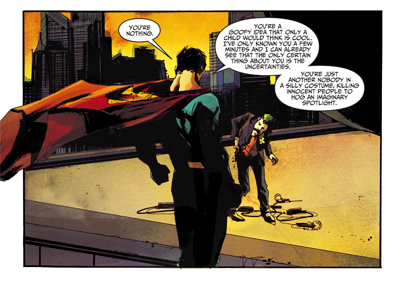
Exploding on to the scene…
The combination of the Joker and Superman is interesting, with Landis hitting on a number of very enlightening and informative comparisons and contrasts. The two fit together remarkably well, which is probably not that big a surprise. After all, Bruce Wayne and Lex Luthor make compelling foils for one another; self-made billionaires who hold themselves above the law. Given that Superman and the Joker exist in opposition to these forces, there is considerable overlap. Both Superman and the Joker are bright and colourful figures; Superman is an alien, but the Joker is “other.”
Landis sets The Sound of One Hand Clapping relatively early in the careers of both characters. “I’m really new to this,” the Joker reflects at one point. Elaborating on his randomness and craziness, he explains, “That’s why I call me Joker. ‘They’ calling me Joker is a work in progress.” There is a sense that the characters are still essentially discovering themselves. Indeed, towards the end of the story, it is revealed that Batman was casually observing the encounter as a way of discovering more about Superman.
The Sound of One Handing Clapping presents both Superman and the Joker as larger than life characters dressed in bright colours. However, it also contrasts the two. Notably, Landis plays the Joker’s cynicism off Superman’s earnestness. He writes the Joker in a knowingly ironic manner. “Wow, okay, is your secret weakness your lack of irony?” the Joker reflects upon seeing Superman arrive. “Over in Gotham we all shop at the same Hot Topic. I have a gift card if you –“

Has the Joker finally Met(ropolis) his match?
However, Landis distinguishes between the type of earnestness that Batman offers to the Joker and the seriousness that Superman affords the character. Notably, Superman is not afraid to smile or laugh at the Joker’s remarks, something that Batman would never allow himself to do. It has been suggested that all the Joker really wants to do is to get a laugh out of Batman, and so Landis teases that expectation by allowing Superman to chuckle at a few of the crazed psychopath’s one-liners.
Landis demonstrates a very canny understanding of the characters here. Indeed, a lot of Landis’ psychology of the Joker is informed by Christopher Nolan and Heath Ledger’s interpretation of the character in The Dark Knight. Much like Ledger’s version of the character consciously (and repeatedly) bristled at the thought of being called “crazy”, Landis’ take on the character seems to get particularly upset when Superman laughs at his gags. “You call yourself the Joker, but I’m not allowed to laugh?” Superman protests.
Landis allows Superman to point out that the character simply cannot be as disorganised as he claims to be while orchestrating these set-ups. “I don’t believe that you didn’t think it out beyond meeting me,” Superman reflects of the Joker’s plan. “You seem kind of smart, and that’s not smart.” Similarly, Landis settles on the same essential take on the character that drove the Dark Knight, suggesting the Joker’s nihilism is marred by insecurity. “Yeah, I mean… it feels like you’re trying too hard,” Superman reflects.

Red eyes, take warning…
There is something quite clever in allowing Superman and the Joker to go head-to-head in a way that emphasises their similarities and their differences. Landis suggests that both Superman and the Joker wear their bright colours as a way of engaging the world in their own flamboyant terms. Superman’s smile and laughter are sincere and optimistic, while the Joker’s own grin and chuckles are cynical and misguided. It is surprising that the pair have not been thrown into conflict more frequently, the difficulty of staging an equal match-up notwithstanding.
That said, Landis also uses The Sound of One Hand Clapping as an excuse to meditate on Superman as a character. This is not particularly surprising. Landis is a writer who has a clear interest in the mechanics of Superman, while Superman lends himself to these introspective pieces. While stories about Batman tend to use the character as a vehicle to explore deeper themes and storytelling motifs, as with Grant Morrison’s seven-year Batman run of the Christopher Nolan Dark Knight trilogy that overlapped with it. In contrast, Superman stories tend to focus on Superman.
This makes a great deal of sense. After all, Superman is a very tough character to write, one who frequently finds relevance in question. Every Superman film brings new questions about the character’s importance, while every attempt to revisit the character’s origin asks tough questions about what the character means at this particular moment in time. While Batman has always been relatively cool, surviving reimagining and reinvention without breaking a sweat, Superman has often struggled to relate to the world around him.
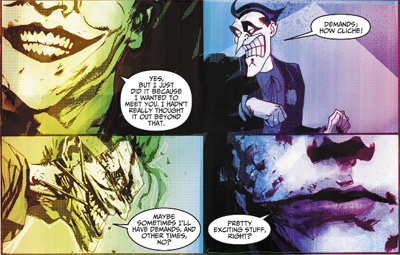
The Joker’s not feeling himself today…
However, this fascination with the mechanics of Superman means that writers occasionally get weighed down in abstract debates about the character’s material worth without every really demonstrating that. At worst, it can feel like Superman writers are wallowing in insecurity, constantly trying at assure audiences that the character has meaning instead of simply showing that the character has meaning. At worst, this leads to cringe-inducing stories like Joe Kelly’s What’s So Funny About Truth, Justice & the American Way?
There are points at which Landis’ script is just a little too essay-like. At certain intervals in The Sound of One Hand Clapping, the Joker and Superman do not so much trade dialogue as offer bullet-point literary critique. “You’re a talking generality!” the Joker accuses Superman at one point. “You’re an ugly archetype!” Superman responds, “I think that’s a strength.” Later, Superman reflects it’s easier for the Joker to be cool. “Any writer could write you, any actor play you, all they need to do is make up their own version and people will applaud.”
To be fair, this doesn’t make any of Landis’ observations unreasonable or unfair. Landis has clearly put a lot of thought into his argument, and understands how the characters in question work. Indeed, The Sound of One Hand Clapping is certainly a more satisfying “Superman rejects cynicism and nihilism embodied by popular characters” story than What’s So Funny About Truth, Justice & the American Way?, if only because Landis has a better grasp of tone and is at once more skilled and more candid in how he employs irony.
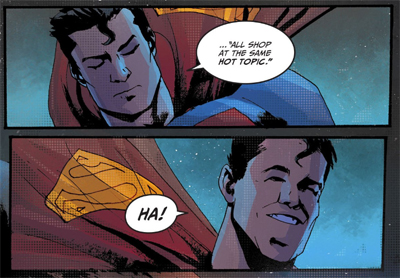
Good joke.
Indeed, there are some wonderful clever touches. Early in the first issue, Landis and Jock have the Joker cycle through some of his more iconic iterations; Aparo, Nicholson, Romero, Bolland, Ledger, Timm. It is a very clever way of demonstrating that the Joker has a flexibility that Superman can never afford. While DC has made attempts to reinvent Superman with “Superman Red/Superman Blue” and so forth, the character simply does not have the fluidity that the Joker (or even Batman) has in terms of remaining cool and accessible.
At the same time, Landis does find himself walking a tightrope with Superman. Landis is careful not to play Superman as a cliché, neither overly naive nor overly trusting in dealing with the Joker. Engaging the Joker in conversation is a stalling tactic for the Man of Steel, rather than an end of itself. He is not above attempting to intimidate the Clown Prince of Crime. Landis writes a version of Superman who does have a little more edge than readers might be used to, which does add some shading.
Still, there are points at which it feels like Landis might be trying just a little bit too hard to make Superman ambiguous. At the end of the story, he has Superman fly into something of a rage at Batman. Superman’s anger is entirely understandable, particularly given that Batman was willing to let the Joker set bombs all over Metropolis to see what Superman would do. However, there are moments at which Landis channels Superman’s righteous anger into pique, having the hero smash a Batmobile to make a point.
All that said, The Sound of One Hand Clapping is a fascinating demonstration of just why DC’s loose out-of-continuity anthology-style comics are so intriguing, affording writers and artists a chance to play with iconic characters on their own terms in a way that can say a lot about those characters.
Filed under: Comics | Tagged: batman, Comics, continuity, dc comics, Jock, joker, Max Landis, superman, the adventures of superman |




















“Joker has a flexibility that Superman can never afford.”
Interesting. The villains change to fit with the times, but the heroes never do.
Oddly, DC affords its villains more space to change than Marvel does. I think it’s because there more film continuities. Or maybe it’s because DC has fewer truly memorable villains, and no one minds a little shake-up. (Of course, Magneto proved there’s such a thing as a little too much change.)
Great write up, D.M.
In the case of Superman, he can’t really be shaken up because his ideals and what he stands for will always be relevant in every era, so he doesn’t need to change too drastically to accomplish it.
That’s an interesting thing about Superman.
I think that there is a lot of interest in changing Superman from generation to generation, in finding something new or radical or insightful to say with him. I just think that very few of them succeed, and most just plunge the character further down the rabbit hole. (See JMS’ Grounded and Earth One as prime examples.)
I don’t think it’s impossible to change Superman from generation to generation, and in fact I think it might be desirable to allow the character a little flexibility, but the creative teams tend to struggle a bit in actually realising that change. (I do quite like the Superman at the start of Morrison’s run and in the Pak/Kuder run.)
Thanks!
To be fair, I think Batman also has a flexibility that Superman doesn’t have either. (Indeed, even Lex Luthor seems prone to change with the times in ways that Superman cannot.) Oddly enough, I’d consider DC’s villains to be stronger than Marvel’s, even if the Marvel heroes are (broadly speaking) more interesting and engaging.
Reblogged this on Jyger's Rant and commented:
“You’re nothing. You’re a goofy idea that only a child would think is cool. I’ve only known you a few minutes and I can already see that the only certain thing about you is the uncertainties. You’re just another nobody in a silly costume, killing innocent people to hog an imaginary spotlight. There is no audience watching you, Joker. No one but you, and you’re clearly already bored. Any writer could write you, any actor play you, all they need to do is make up their own version and people will applaud. But no one will ever actually applaud YOU.”
…Man, Joker’s been punched in the face so many times by Batman that he’s probably got his permanent fist-mark in his cheek, but THAT must’ve left a mark! XD
Ha! Landis’ dialogue can be a little too self-aware and “this is an essay written by Max Landis delivered by Superman”, but he does write some great zingers. (I’d argue Landis is a fantastic pop culture critic in his own right.)
I have not seen a verbal assassination of the Joker this bad since the Batman Beyond movie. lol
It’s been far too long since your last comics review. Glad to see them make a resurgence.
Thanks Kyle. There’ll be about three a week for the next few weeks, at least until Daredevil launches. But it has been fun diving back in.
I would like to point out the entire motivation for the Joker, across all incarnations, is his whole motivation is he wants to defeat Batman, in any and all ways.
I think that’s certainly valid, but you do run into issues when you have to position him in the larger DC universe. Similarly, Luthor fixates almost monomaniacally on Superman, but that doesn’t mean that he can’t have fun interactions with Batman or that he can’t make bolder philosophical statements.